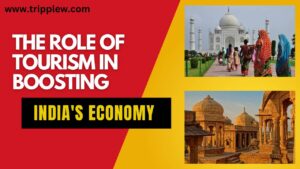
The Role of Tourism in Boosting India’s Economy
Introduction
Tourism plays a vital role in shaping the Indian economy, contributing significantly to GDP, employment, and cultural exchange. India, known for its diverse landscapes, historical monuments, and rich heritage, attracts millions of tourists every year. From the snow-capped peaks of the Himalayas to the sun-kissed beaches of Goa, the country offers something for every traveler. In this blog, we explore how tourism has become an economic driver in India and its broader impact on growth and development.
Role of Tourism in the Indian Economy
1. Contribution to GDP
Tourism is one of the key sectors that add substantially to India’s Gross Domestic Product (GDP). According to the World Travel & Tourism Council (WTTC), the travel and tourism industry contributed around 6.8% to India’s GDP in 2019. This figure underlines the sector’s importance in the country’s overall economic structure.
2. Employment Generation
The tourism sector is a massive employer, providing direct and indirect jobs to millions of Indians. From hotels, transport services, and tour operators to local artisans and street vendors, tourism sustains a large workforce. According to data, the tourism industry accounted for 12.75% of the total employment in India.
3. Boosting Local Economies
Tourism often thrives in rural and less developed areas, creating opportunities for local communities. It encourages the growth of small businesses such as handicrafts, traditional food outlets, and homestays, which showcase the local culture to tourists while generating revenue.
4. Foreign Exchange Earnings
Tourism is a major source of foreign exchange for India. International tourists visiting India contribute significantly to the nation’s reserves. In 2019, India earned approximately $30 billion from international tourist receipts, which helped stabilize the balance of payments.
5. Promoting Infrastructure Development
To accommodate the rising number of tourists, India has witnessed significant improvements in infrastructure. Airports, roads, hotels, and transport facilities have seen upgrades, leading to overall better living conditions for local citizens and making India a more attractive tourist destination.
6. Cultural Preservation and Promotion
Tourism plays a critical role in the preservation of India’s cultural heritage. By promoting traditional crafts, festivals, and historical sites, tourism helps in maintaining the country’s cultural fabric while simultaneously educating visitors about its rich history.
Challenges in the Tourism Sector
While tourism has been a boon for the Indian economy, it faces certain challenges like over-tourism, environmental degradation, and infrastructure constraints in some regions. Government policies are crucial to addressing these challenges and ensuring sustainable growth in this sector.
Conclusion
Tourism holds enormous potential for boosting India’s economic growth by contributing to GDP, creating jobs, and earning foreign exchange. With a proper focus on sustainable tourism, India can continue to harness its unique heritage and natural beauty while safeguarding its environmental and cultural assets for future generations.
—
Disclaimer :
The information provided in this blog is for educational and informational purposes only. The data and statistics referenced are based on publicly available sources and may vary over time. The blog does not offer professional advice or guidance and should not be construed as such. ‘Triple W‘ will not be held responsible for any discrepancies or errors in the content.
—